Content marketing is a long-term strategy. Usually, you won’t see a positive return on your content investment (ROI) until months after publication. This long gestation period is why tracking content performance is crucial.
Choosing simple, relevant content marketing metrics is the best way to track if your content campaigns are achieving your brand’s Key Performance Indicators (KPIs). Plus, when you start measuring performance early, it’s easier to spot what content resonates or flounders with your users.
This post identifies 16 of Portent’s favorite content KPIs, sorts the content metrics by the goals they’re best at measuring, and tells you how to start tracking your content marketing efforts.
How to Measure Content Performance: Establishing and Setting Content Marketing KPIs
Ideally, your KPIs are composed of quantitative, relevant, and easy-to-calculate content metrics that can measure performance over time and across all levels of the conversion funnel.
To distinguish between relevant KPIs and metrics, we recommend following Aleksey Savkin’s rule of thumb.
Savkin recommends:
“If you are not sure if you are dealing with a KPI or a simple metric, do a simple test: imagine that you can double the value of this indicator. If you expect the performance of the business to be increased significantly, then it’s a good KPI for your business context. If not, then it is a simple metric.”
If you’re trying to set KPIs for your content, find the numbers where you really want to move the needle and use those values as metrics that matter most.
A Chart of Portent’s Favorite Content KPIs
When you’re planning your KPIs, keep the conversion funnel top of mind; you should be able to measure content performance during every step of the conversion funnel. To help you get started, here’s an illustration showing how Portent breaks down content KPIs according to the different stages of the customer journey and their overlap.

In our content marketing strategies, users are funneled through journeys that result in three goals:
- Conversion
- Reputation
- Engagement
Each goal within these journeys has a few ideal KPIs. Some KPIs can be used to measure success across more than one goal. If you’re only interested in one KPI category, use the jump links in the previous bulleted list to skip ahead.
If you want to learn more about measuring the long, messy game of content marketing then keep reading. We’ve included descriptions of all the content KPIs and how they interact with each other.
Content Metrics: Conversion KPIs
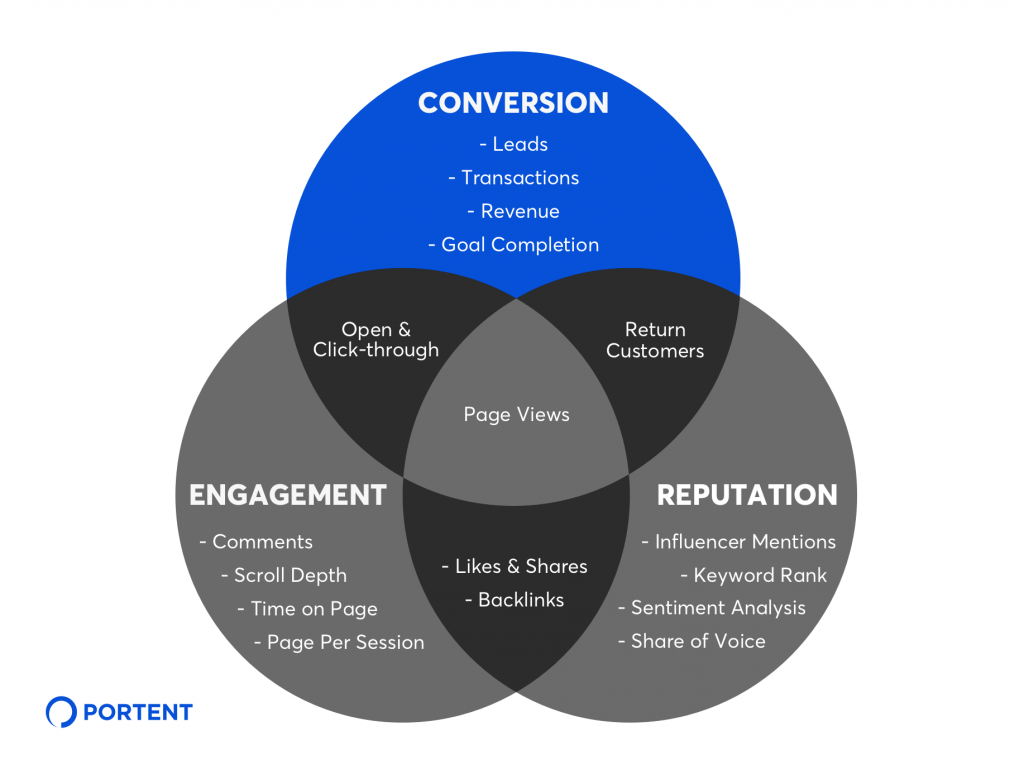
Leads
If you’re writing content that’s meant to generate leads, you should track how many leads you’re generating.
For example, if you’re debuting a new gated resource, you should measure how many new leads that resource brings in. Afterward, compare that number to the leads generated by other gated resources.
This analysis will answer some critical strategy questions:
- What are your customers looking for?
- Are your customers willing to give up their contact information to get your content?
- What kind of content generates the most qualified leads?
Transactions & Revenue
For businesses focused on driving e-commerce revenue and transactions through their website, we highly recommend Google Analytics e-commerce tracking. Within those reports, add the secondary dimension of “landing page” to see how many people purchased after touching a piece of content you produced. This metric allows you to discover what copy has the highest transaction or revenue level.
If you use revenue as a KPI, your findings will vary according to how much a customer spends. If you’re just curious about how many people eventually converted after touching your content, and you don’t care how much they wound up spending, use “transactions” instead of “revenue” as the guiding metric.
Goal Completions
If you don’t have enough transactions or revenue to see how those figures interact with your content, you can set goals inside Google Analytics that allow you to track conversions without a dollar value. You can see what URLs accomplished which goals you’ve set. A non-monetary goal might be filling out a form, making a phone call, or joining an email list.
Below is an example of what a goal completion KPI looks like.

Content Metrics: Reputation KPIs
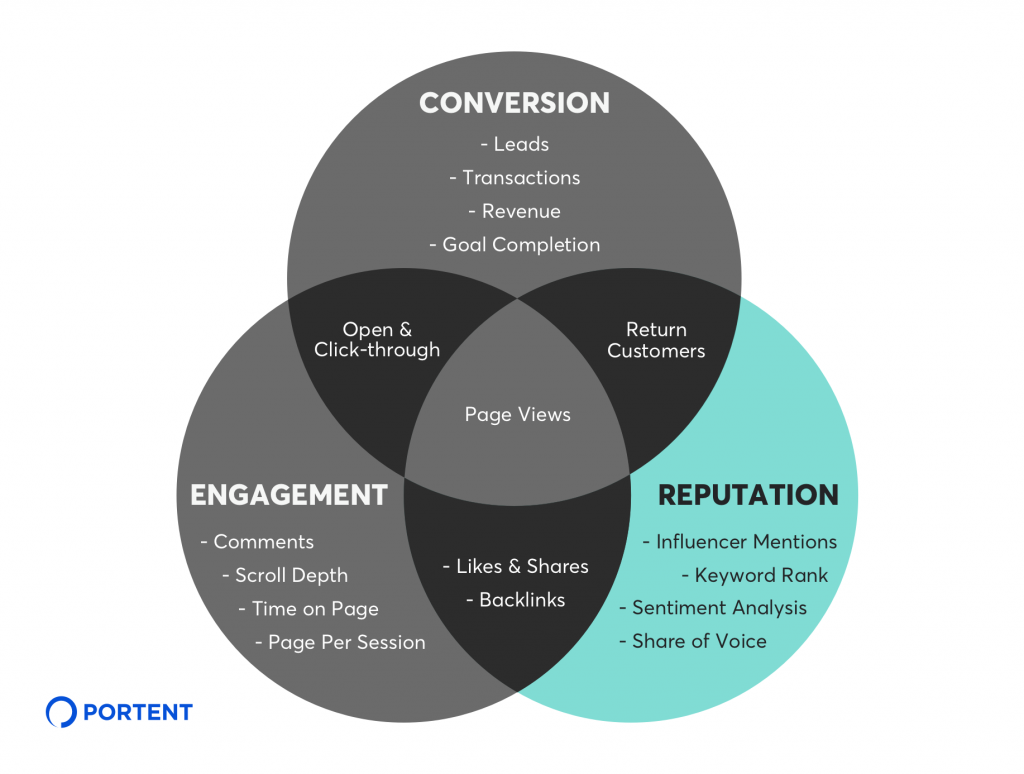
Influencer Mentions
Did key industry influencers mention your content? Even if they didn’t link back to you, mentions help your reputation. You can measure mentions with a tool like Sparktoro, or by creating a Google Alert for mentions of your brand or a particular content campaign. It’s also beneficial to track whether those mentions are positive or negative.
Keyword Ranking
If you build a content campaign around a targeted keyword, make sure you’re tracking your success. There are a lot of tools on the market for tracking your keyword rankings, such as Ahrefs and SEMrush. Portent uses STAT, a SERP-tracking tool out of Vancouver, Canada, for most of our SEO and content development campaigns.
Here’s an example of what SERP position tracking looks like in STAT. We chose Portent’s ranking for the term “choosing content KPIs.”

When you show up high in the SERPs, you’re building your reputation with Google, its crawlers, and potential site visitors who are browsing search results. Even if they don’t click on your page, they’ll still see it in their query results, which improves awareness.
Share of Voice

Another useful metric that STAT offers is Share of Voice (SoV). This KPI measures how visible a keyword set is on Google.
STAT says the concept follows two principles:
- Not all rankings are equal, and higher ranks give you more Share of Voice.
- Not all keywords are equal, and earning a keyword with higher search volume gives you more Share of Voice.
You can use SoV to determine how your content is affecting brand exposure on SERPs. It’s a great KPI to monitor if you’re launching a brand-awareness campaign or implementing a content hub project.
Sentiment Analysis
Sentiment analysis is a complicated topic that’s usually relegated to social media, but major brands can leverage this AI technology to track the way people are talking about their content campaigns, too. Sentiment analysis measures reputation from your social media mentions. If you just launched a new educational center, for example, this metric is a useful way to keep your ear to the ground for relevant Twitter chatter.
For a deep and technical dive into sentiment analysis, we recommend this story on Yelp from Stack Overflow’s David Robinson. For something higher-level, Brandwatch is one of the oldest names in the business and offers a clear, accessible explanation.
Content Metrics: Engagement KPIs
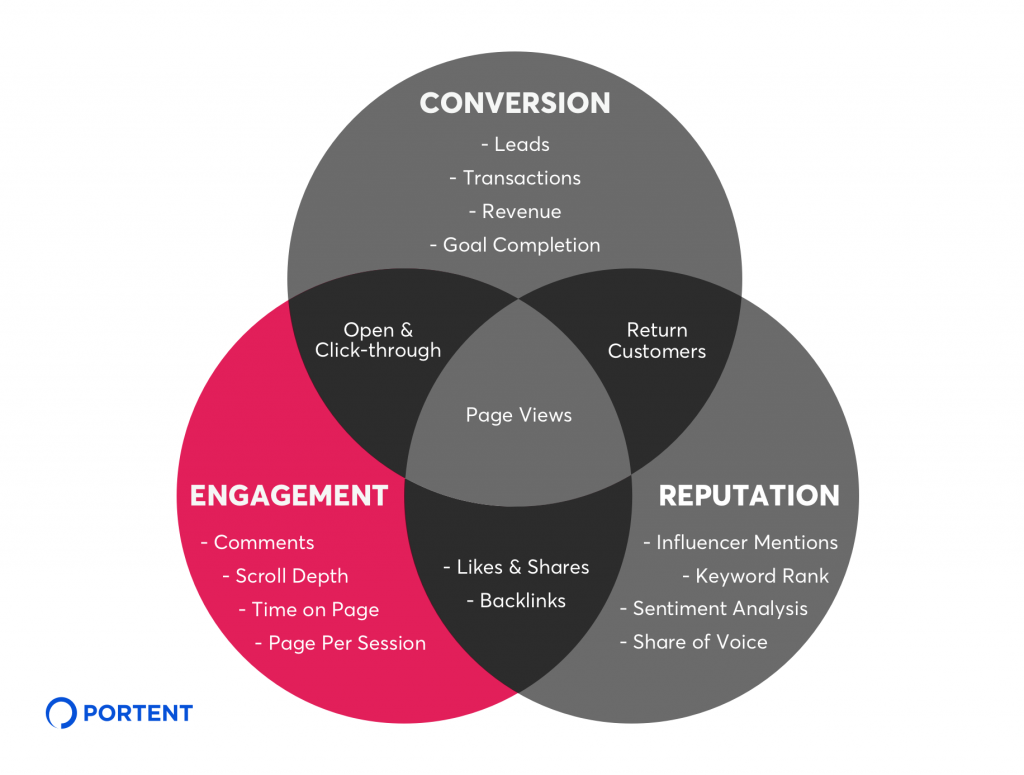
Comments
Are people commenting on your blog post with valuable insights, questions, or feedback? If you write a blog post that gets through to people, they’ll often show it in the comments. Tracking this engagement KPI will help you learn what topics resonate with users and spark conversations.
For example, check out these comments on Ian Lurie’s blog post, The Digital Marketing Checklist: 48 Things You Should Be Doing But Probably Aren’t.
People read it, considered its points, and then responded thoughtfully:

As with any robust comments section, it’s important to meaningfully engage with users, too. This interaction helps build brand loyalty and further improves the value of comments as a KPI.
Scroll Depth
If you want an easy, fast way to tell whether or not people are reading your content, look at the scroll depth of the page.
Most heat mapping programs, such as Hotjar, will provide you with scroll depth tracking. After you’ve set up tracking on the page through Google Tag Manager and the heat mapping platform, take a look at your scroll depth maps. You can see where your readers are dropping off and how fast. A rapid drop might mean your content needs to be reworked.
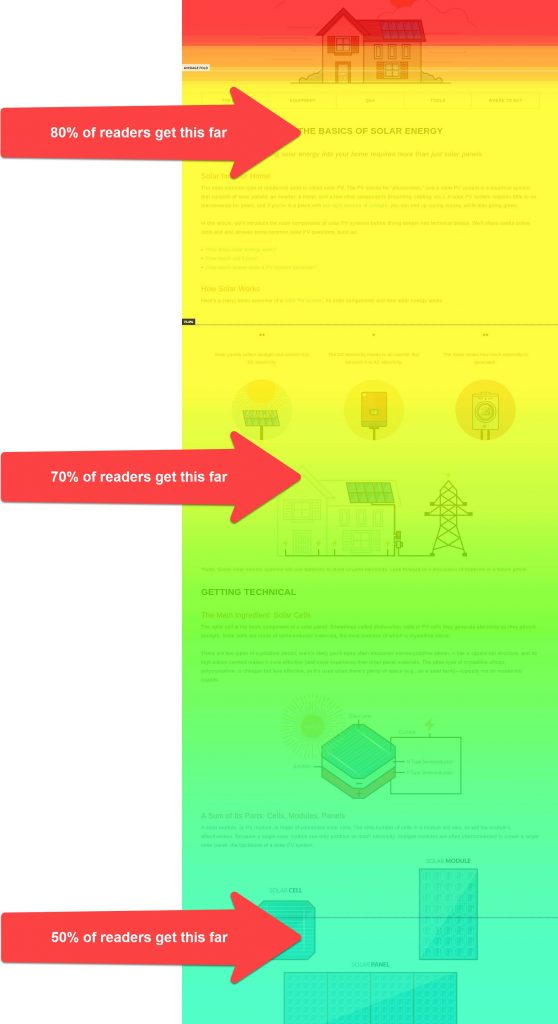
Time on Page
Time on page is a similar key performance indicator to scroll depth in that it shows you how long people typically spend reading your content. Instead of being measured in pixels, however, this KPI is measured in seconds.
If you’re creating a new content strategy for your blog, your goal might be to increase the average time on page for new blog posts. Generally, the longer someone spends on your page, the more they’re engaging with your content, which means you’ve successfully earned their attention.
However, it’s important to keep in mind that time spent is related to the content length. Don’t compare the content of different types and lengths for time on page. A 2,000-word guide will probably have a much longer time on page than a 300-word blog post, but 50 percent of readers might make it all the way through that blog post versus only 10 percent who read your whole guide.
Pages Per Session
You can swap out this KPI with bounce rate if you prefer — they both tell you if readers are leaving your site after viewing your content. But bounce rate only tells you the ratio of visitors who leave versus those who keep digging deeper; the average pages per session will tell you how many pages they visit.
What’s a good rate for average pages per session? This depends entirely on your business. Generally, a site that serves to generate leads will have fewer pages per session than an e-commerce site, where users often spend time browsing product pages. If your e-commerce site doesn’t see an average rate of pages per session of three or four, you need to retool your strategy. In comparison, if a blog post on the Portent site has a rate of pages per session more than two, it’s excelling at this KPI.
Content Metrics: Conversion & Reputation KPIs

Return Customers
Returning customers are the intersection of reputation and conversion. They know your brand, they like it, and they want more.
It’s hard to measure the impact of content on returning customers, but you can use Google Analytics to set tracking codes from the “thank you” page or log-in screen.
From here, you can see what kinds of content this group interacts with. Here are a few questions to consider when evaluating return customers:
- Do your returning customers visit your blog?
- Do they read your long-form content?
If not, why?
If so, which ones are popular?
Content Metrics: Reputation & Engagement KPIs

Likes & Shares
Social media is one of the best barometers for gauging the success of your content. The more likes and shares, the better the content is performing in terms of engagement, which affects your reputation.
Social media is sensitive to many factors. If you want to measure the impact of your content based on the content’s virtues alone, promote different content pieces with the same amount of money to lookalike audiences at the same time of day. If a piece does well, throw the rest of your promotional budget behind it. And then create more content like the winning article.
Backlinks
Backlinks are one of the most crucial KPIs for content — for many writers, they are the carrot on the other end of the stick. They are also a valuable barometer for assessing who respects or enjoys your content to the point they’re willing to recommend it to others.
As SEOs often say, every link is like a vote. When you receive unsolicited backlinks from authoritative sites, your readers are engaged, and your reputation is growing in the eyes of both readers and Google’s ranking algorithm.
Content Metrics: Engagement & Conversion KPIs
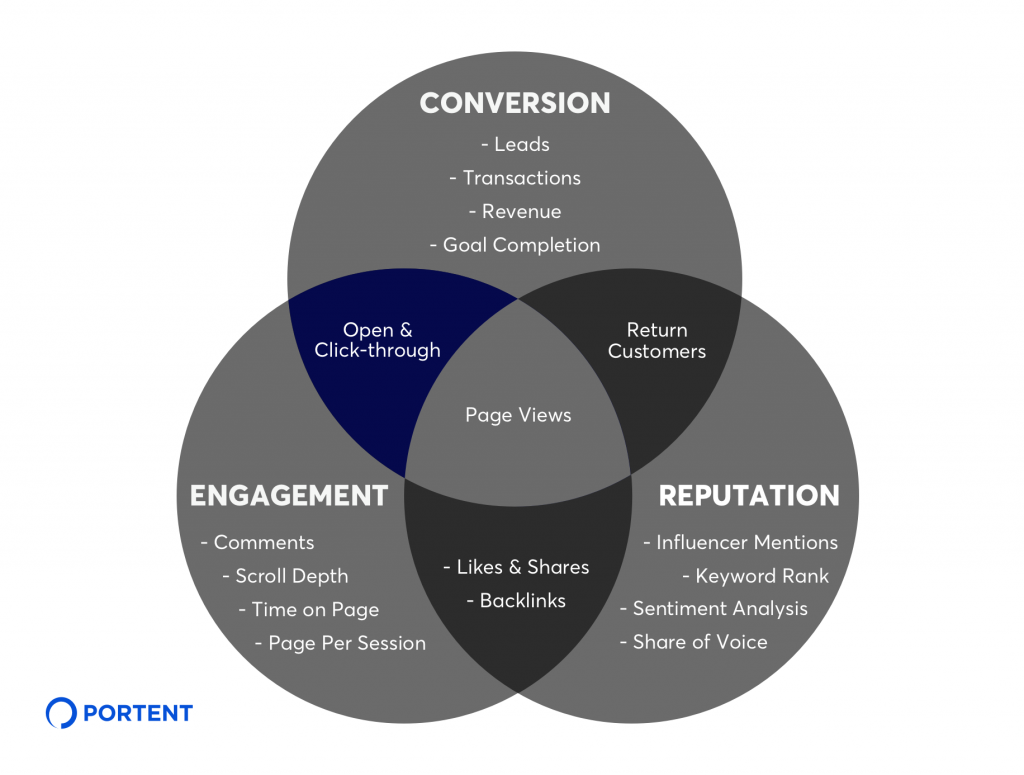
Open and Click-Through Rates
These are the KPIs for measuring conversions and engagement with email marketing campaigns. Your site’s content extends to all owned channels, and that means email, too. If you aren’t setting KPIs for your email marketing campaigns, you’re squandering one of your few opportunities to speak right into a customer’s ear.
Content Metrics: Conversion & Reputation & Engagement KPIs

Page Views
Without visitors, you’re not going to engage, convert, or build any kind of online reputation. The more people who view your site, the more people are engaging with your brand, and the more your reputation spreads. And the wider your reach, the more likely you’ll generate conversions.
Page views are the easiest way to measure the success of content. Unsurprisingly, they’re also the most popular. And some might even say the laziest.
Unless you’re combining page views with some other metric, you’re going to be missing a big part of the picture. What sets apart great marketers is their ability to layer a versatile yet surface-level metric like a page view with other KPIs to understand whether and how a piece of content connects with readers. A click-bait headline, for example, might generate a lot of page views, but if the content doesn’t address users’ needs, the time on page won’t be very long, the pages per session will be low, and you probably won’t get any backlinks. So use this KPI in conjunction with others.
Tying it All Together
So there you have it!
We’ve shared the 16 KPIs we look to monitor when evaluating the effectiveness of content.
As we have shown, evaluating the effectiveness of your content marketing efforts requires patience and careful planning. There is not one right way to track the success of your content — it’s all about identifying your goals, setting KPIs, and then iterating to find what works well for you.
So go on! Test and try a handful of metrics to find the right mix of what works for you.










Content is king of the website so it’s nice information and thanks for posting. It is so helpful for content writers and who’s interest to learn content writing for improving their skills.